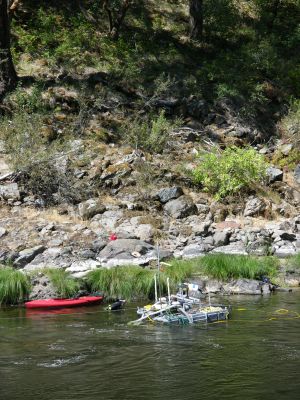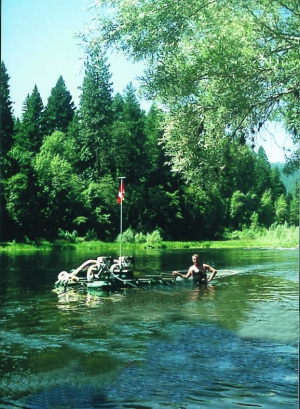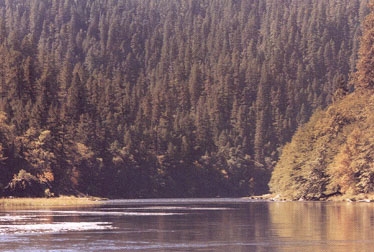BY PAUL BADALI

Since we’re still in the mainstream of the dredging season, I’ve decided to share a few tricks I’ve picked up in my experiences with dredging over the past few years. Hopefully they will help to make your dredging a little easier.
After several seasons of use, dredge hose becomes cracked and needs to be replaced. I have tried to repair the cracks and holes in my 5-inch yellow hose with silicone R.T.V. glue, that didn’t work; so I knew I would be replacing it. The only 5-inch hose I could find in the dry desert state of Utah was a very light duct hose called Spirolite, which is used to blow insulation into attics. The hose is so light and thin that I decided both the first and second time I went in to purchase some it could not hold up under dredging conditions. But the price was so good (about $3.90/foot for 5-inch) that I finally bought a 10 foot length just to see how it would hold up in the Klamath River. I liked it so well that when Tony Dilmore, who had originally recommended it to me, showed up in Happy Camp with some, I bought another 20 foot length from him.
Spirolite has definite advantages in some dredging applications. First of all, it is extremely flexible. It is ideal for creek dredging where the hose often must be wrapped around boulders. Secondly, it is extremely lightweight weighing only about half what the yellow hose weighs, so it’s easier to pack down the bank or into remote dredging sights. It does not show excessive wear as I had feared it might. When I first looked at this hose, I pinched my thumb nail and finger nail together on the thin clear material between the spiraled ribs and was able to pinch a hole in it. But I can’t see any holes in my 20 foot section of hose after half a season’s use in the Klamath River. So, it seems to hold up well. It does develop small holes where it is clamped to the nozzle and the jet, but these areas are at the end of the hose and can easily be cut off when they get bad. And at $4/foot, you can afford to take this into account and buy five feet more than you need. And as for beating out plug-ups, you don’t have to. This hose is so flexible that it rarely plugs-up. If a rock does turn sideways and plug, you simply deform the hose with your hands, and the plug frees with no hammering on the hose!
There is one application where a heavier, stiffer hose is preferred over the Spirolite, and that is in deep or fast water. Because the hose is so light and flexible, the water can grab it and keep pulling it out of your hole. When I used this hose in the gut of the “Glory Hole” on the Klamath in about 15 feet of water, I had to keep the dredge near the edge of the river, use 30 feet of hose, and anchor it to the bottom at two points on the way out into the gut. The nozzle still washed out each time I went up to knock a plug out. But for calmer more shallow water, it’s the hose I prefer to use.
You should be able to get it at most large hose supply stores in larger cities. If they don’t recognize the brand name Spirolite, ask for the lightweight clear spiral duct hose they use to blow insulation into attics with, and get prices at three or four hose supplies. You may get it even cheaper than I did!
Has your swivel nozzle stopped swiveling after two seasons of use? Mine had. Sand and small rocks work their way down into the joint, and rust accumulates in there over the winter. But if you have access to an arc welder, the repair job is simple. Just cut or grind off the weld beads that hold the swivel joint to the nozzle, and remove the swivel joint. Inside you will find two rubber O-rings or pieces of rubber cord cut to work as O-rings. Pull the whole assembly apart, and use a wire brush to buff rust and sand off of all the metal parts. Clean the rubber cord or O-rings in water.
You want to catch any sand that falls out, and pan it. I found one nice flake of gold inside my nozzle when I cleaned it. You may wish to use some type of non-oil lubricant in the swivel joint before you reassemble it, such as graphite or silicone. I haven’t done this yet, but I suspect graphite is the way to go.
To reassemble, simply match the old ground-off beads back up, and tack it in the same spots with an arc-welder. I would not gas weld these beads, as I suspect it would get the rubber O-rings too hot and damage them. When you are done, your nozzle should swivel as good as new. While you have the welder in hand, touch up any wear you see elsewhere on the nozzle.
This last winter, I got about 26 feet of 36-inch-wide miner’s moss free! You may be able to do the same. I noticed that miner’s moss was used on the floor as mats in every entrance at a local high school. I found the janitor and asked if he would keep me in mind, and give me any old pieces he might be throwing out in the future. He was curious as to why I would want old mats, and we got into an hour’s discussion about dredging for gold. At the end of our chat, he said, “You know, I think we have a few old pieces we’re throwing out in a store room right now.”
We went to look, and he helped me wheel out three six-foot pieces, and one eight-foot piece of miner’s moss. They needed some cleaning up, but hanging the carpets on the kid’s swing set and using the garden hose soon took care of that.
The moral of this story is ASK. If you want something, ask. If you think people will say no, nine times out of 10, then just ask 10 people, and you’ll get what you want. Everyone has seen miner’s moss being used for foot mats. The U.S. Postal Department uses it, supermarkets do, banks do, etc. They all have to throw out the old and replace it with new. So ask for the old mats, and chances are you will get some!
I would also like to give some advice on moving your small-size dredge around on a big river like the Klamath. If you are not a good swimmer, and you are scared to death to swim across; then listen to your intuition, and stay on the side you’re already on. Know your own limits, and don’t get yourself into trouble. But, if you’re an average swimmer, and just a little apprehensive, then here are some tips on getting yourself, the dredge, gas supplies, and concentrates back and forth across the river without a boat.
Number one, buy a good set of fins. Good fins fit over your wet suit booties and are fairly stiff. They are not so stiff that they feel like cedar shingles, nor so soft that you can touch the tip of the fin to the heel, but somewhere in between. With a good set of fins, you have about as much power in your legs as a 2-hp outboard motor, and you can really cruise across that river! Always wear your wet suit without weights when crossing, and take it easy. If you’re not used to pumping fins, you can quickly get a leg cramp from over exertion.
The current will pull you downstream as you swim. Pick a calm stretch of river to swim across, and start way up stream from where you want to end up. Don’t choose a calm spot immediately above bad rapids, because if you don’t make it, you will be going for a very bouncy ride. If you are crazy like I am, this can be lots of fun, but it can also freak out your wife who watches the ride from shore!
To swim across, just float on your back, point yourself towards the other shore, and pump your legs. Don’t try to head up- stream and fight the current! Just start way upstream from where you want to land on the other side, and take a relaxed ride. The fins do all the pushing, just let your arms dangle. With fins and a wet suit on, it’s easy as swimming in a lake. 
To take my dredge across, I load everything onto it, and push on the tail-end of the sluice box while kicking with my fins. I do not like a rope tied from the dredge to the shore. I do not swim a rope across first, and let that rope pull the dredge in. I play outboard motor with my fins, and I propel the dredge to the other bank. I lie on my stomach if pushing, or on my back if pulling. I feel much more in control of the dredge this way. I do choose a very calm stretch of river to do this, and I give myself twice the distance upstream that I think it will take to get across. It’s easy this way for one guy to get a dredge across by himself, and it’s a breeze if you have a helper also wearing fins.
Supplies and concentrates are also easy to get across. If you use a large 30-gallon tub to dump your concentrates into, you already own a small boat. You can put your weight belts, winch, tools, towels, etc. into the tub, and pull it with you as you lie on your back and kick across. It will sink if you tip it, and an inflated inner tube around the tub adds safety and more buoyancy. You can pull people in dry clothing across in a small rubber raft as fast or faster than they can paddle. You can also very easily swim a motorized sluice (high-banker) across the river in a small raft or an inner tube. You can fit lots more cargo in a rubber raft if there is no one in the boat! Obviously, when you want to come back across the river, you have to walk upstream; because you will be washed downstream as you swim back across.
There really isn’t much to fear from a big river if you are careful. You float like a cork in a wet suit. Don’t fight the current! The current is stronger than you are, so “go with the flow,” and let it work for you. Get good fins, so you have some push, and have a good time with it. In most cases, there has been less prospecting and mining done on the other side, so you may reap great rewards for your investment in a pair of good fins!
Good luck, and see you out there!





